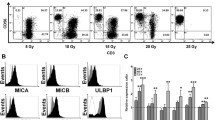Abstract
A certain number of pédiatrie cancer patients still succumb to relapse following conventional treatment of their malignancies. One of the mechanisms of relapse is escape from immunity. Adoptive cellular immunotherapy with effector cells has the potential to overcome this escape. In adults, the CD3+CD56+ cell, a cytokine-induced killer (CIK) cell, appears to be a promising effector cell type with the greatest cytotoxicity. This effector cell type may work in children as well. No similar studies with children have been published. We speculated that expanded CD3+CD56* cells obtained from pédiatrie cancer patients during remission would act similarly against various pédiatrie tumor cell lines; therefore, we undertook the present study to find support for our speculation. This study was undertaken to generate and expand CD3’CD56’ CIK cells from normal peripheral blood mononuclear cells (PBL) obtained from 6 children with cancer (2 with acute lymphoblastic leukemia, 2 with large cell lymphoma, and 2 with osteosarcoma) in remission after intensive chemotherapy and to study the cytotoxic activities of these cells against chronic myeloid leukemia cell line K562 t(9:22), 4 pédiatrie tumor cell lines [infant acute lymphoblastic leukemia RS4 t(4;ll), THL/AML acute lymphoblastic leukemia REH t(12:21), alveolar rhabdomyosarcoma Rh-Cr t(2;13), and Ewing sarcoma EW-Le t(11;22)], and 2 pédiatrie glioblastoma multiforme cultured cell lines (G74 and G77). CIK cells were generated and expanded in culture medium to which interferon y, monoclonal antibody against CD3, and interleukin 2 were added at appropriate times. Cells were counted by flow cytometry. Net lactate dehydrogenase release from target cells incubated with CIK cells was used as an index of CIK cell cytotoxicity against various pédiatrie tumor cell lines. Ihe results show that after 21 days in culture CD3*CD56+ CIK cells derived from the 6 pédiatrie patients accounted for a median of 28.3% of the entire culture (range, 10.7%-36.4%). Before expansion no such cells were found in any of the 6 children. Median lytic activity rates of CIK cells were 45.5% to 64.5%, rates that contrasted drastically to the lytic activity rates of PBL, which were only 8% to 12%. The findings of the present study are encouraging. They provide information for developing adoptive immunotherapy for future clinical trials with pédiatrie cancer patients, particularly those patients with minimal residual disease after intensive chemotherapy or stem cell transplantation (especially nonmyeloablative transplantation procedures).
Similar content being viewed by others
References
Parker SL.Tong T, Bolden S, Wingo PA. Cancer statistics, 1997.CA Cancer.!Clin. 1997;47:5–27.
Rosenberg SA, Spiess PS, I.afreniere R. A new approach to the adoptive immunotherapy of cancer with tumor-infiltrating lymphocytes.Science. 1986;233:1318–1321.
Rosenberg SA, Packard BS, Aebersold PM, et al. Use of tumorinfiltrating lymphocytes and IL-2 in the immunotherapy of patients with metastatic melanoma.N EnglJ Med. 1988;319:1676–1680.
Rosenberg SA, Lotze MT, Yang JC, et al. Prospective randomized trial of high-dose interleukin-2 alone or in conjunction with lymphokine-activated killer cells for the treatment of patients with advanced cancer.J. Natl Cancer Inst. 1993;85:622–632.
Faber LM, van Luxemberg-Heijs SAP, Willemze R, Falkenburg JHF. Generation of leukemia-reactive cytotoxic T-lymphocyte clones from the HLA-identical bone marrow donor of a patient with leukemia.J. Exp Med. 1992;176:1283–1289.
Oettel KR,Wcsly OH, Albertini MR,et al. AllogeneicT-cell clones able to selectively destroy Philadelphia chromosome (Phl-f) human leukemia cell lines can also recognize Phi.....cells from the same patient.Blood. 1994;11:3390–3402.
Schmidt-Wolf IG, Lefterova P, Mehta BA, et al. Phenotypic characterization and identification of effector cells involved in tumor cell recognition of cytokine-induced killer cells.Exp Hematol. 1993;21:1673–1679.
Schmidt-Wolf IG, Lefterova P, Johnston V, et al. Sensitivity of multidrug-resistant tumor cell lines to immunologie effector cells.Cell Immunol. 1995;169:85–90.
Scheffold C, Brandt K, Johnston V, et al. Potential of autologous immunologie effector cells for bone marrow purging in patients with chronic myeloid leukemia.Bone Marrow Transplant. 1995;15:33–39.
Schmidt RE, Murray C, Daley JF, Schlossman SF, Ritz J. A subset of natural killer cells in peripheral blood displays a mature T cell phenotype.J. Exp Med. 1986;164:351–356.
Lanier LL, Le AM, Civin CI, Loken MR, Phillips JH. The relationship of CD 16 (I,eu-ll) and Leu-19 (NKH-1) antigen expression on human peripheral blood NK cells and cytotoxicT lymphocytes.J Immunol. 1986;136:4480–4486.
Ortaldo JR.Winkler-Pickett RT, Yagjta H, Young HA. Comparative studies of CD3~ and CD3+CD56+ cells: examination of morphology, functions,T cell receptor rearrangement, and pore-forming protein expression.Cell Immunol. 1991;136:486–495.
Lu PH, Negrin RS. A novel population of expanded human CD3+CD56+ cells derived from T cells with potent in vivo antitumor activity in mice with severe combined immunodeficiency.J. Immunol. 1994;153:1687–1696.
Lefterova P Buttgereit FSR Scheffold C, Huhn D, Schmidt-Wolf IGH. Expansion of CD3+CD56+ cytotoxic cells from patients with chronic lymphocytic leukemia: in vitro efficacy.Haematologica. 2000, 104:72–79.
Hoyle C, Bangs CD, Chang P, Kamel O, Mehte B, Negrin RS. Expansion of Philadelphia chromosome-negative CD3+CD56 cytotoxic cells from chronic myeloid leukemia patients: in vitro and in vivo efficacy in severe combined immunodeficiency disease mice.Blood. 1998;92:3318–3327.
Verneris MR, Kornacker M, Mailander V, Negrin RS. Resistance of ex vivo expanded CD3+CD56+ T cells to Fas-mediated apoptosis.Cancer Immunol Invnunother. 2000;49:335–345.
Mehta BA, Schmidt-Wolf IG, Wcissman IL, Negrin RS. Two pathways of exocytosis of cytoplasmic granule contents and target cell killing by cytokine-induced CD3’CD56’ killer cells.Blood. 1995;86:3493–3499.
Wood GW, Holladay FP, Turner T, Wang YY, Chiga M. A pilot study of autologous cancer cell vaccination and cellular immunotherapy using anti-CD3 stimulation lymphocytes in patients with recurrent grade III/IV astrocytoma.J. Neurooncol. 2000;48:113–120.
Leemhuis T, Wells S, Horn P, et al. Autologous cytokine-induced killer cell for the treatment of relapsed Hodgkin’s disease and nonHodgkin’s lymphoma [abstract].Blood. 2000;96:839a.
Baker J, Verneris M, Ito M, Shizuru J, Negrin RS. Expansion of cytolytic CD8 natural killer T cells with limited capacity for graftversus-host disease induction due to interferon-y production.Blood. 2001;97:2923–2931..
Author information
Authors and Affiliations
About this article
Cite this article
Hongeng, S., Pctviscs, S., Worapongpaiboon, S. et al. Generation of CD3+CD56+ Cytokine-Induced Killer Cells and Their In Vitro Cytotoxicity against Pediatric Cancer Cells. Int J Hematol 77, 175–179 (2003). https://doi.org/10.1007/BF02983217
Received:
Revised:
Accepted:
Published:
Issue Date:
DOI: https://doi.org/10.1007/BF02983217




